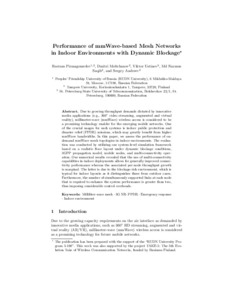Performance of mmwave-based mesh networks in indoor environments with dynamic blockage
Pirmagomedov, Rustam; Moltchanov, Dmitri; Ustinov, Viktor; Saqib, Md Nazmus; Andreev, Sergey (2019)
Pirmagomedov, Rustam
Moltchanov, Dmitri
Ustinov, Viktor
Saqib, Md Nazmus
Andreev, Sergey
Teoksen toimittaja(t)
Di Felice, Marco
Natalizio, Enrico
Bruno, Raffaele
Kassler, Andreas
Springer Verlag
2019
Julkaisun pysyvä osoite on
https://urn.fi/URN:NBN:fi:tuni-202011167982
https://urn.fi/URN:NBN:fi:tuni-202011167982
Kuvaus
Peer reviewed
Tiivistelmä
Due to growing throughput demands dictated by innovative media applications (e.g., 360°) video streaming, augmented and virtual reality), millimeter-wave (mmWave) wireless access is considered to be a promising technology enabler for the emerging mobile networks. One of the crucial usages for such systems is indoor public protection and disaster relief (PPDR) missions, which may greatly benefit from higher mmWave bandwidths. In this paper, we assess the performance of on-demand mmWave mesh topologies in indoor environments. The evaluation was conducted by utilizing our system-level simulation framework based on a realistic floor layout under dynamic blockage conditions, 3GPP propagation model, mobile nodes, and multi-connectivity operation. Our numerical results revealed that the use of multi-connectivity capabilities in indoor deployments allows for generally improved connectivity performance whereas the associated per-node throughput growth is marginal. The latter is due to the blockage-rich environment, which is typical for indoor layouts as it distinguishes these from outdoor cases. Furthermore, the number of simultaneously supported links at each node that is required to enhance the system performance is greater than two, thus imposing considerable control overheads.
Kokoelmat
- TUNICRIS-julkaisut [16951]
